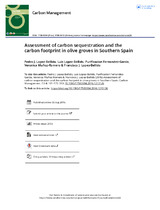Assessment of carbon sequestration and the carbon footprint in olivegroves in Southern Spain
Autor
López-Bellido Garrido, Pedro José
López Bellido, Luis
Fernández García, María Purificación
Muñoz-Romero, Verónica
López-Bellido, Francisco J.
Editor
Taylor & FrancisFecha
2016Materia
Olea europaeaCarbon sequester rate
Greenhouse gas emissions
Soil organic carbon
Biomass carbon
METS:
Mostrar el registro METSPREMIS:
Mostrar el registro PREMISMetadatos
Mostrar el registro completo del ítemResumen
Tree plantations are characterized by their ability to remove CO2 from the atmosphere and store it in a stable manner in tree structures (trunks, roots and branches) as well as in the soil. The study was conducted in Southern Spain in olive groves and covering an area of 1121 ha, where 22 homogenous plantation units were selected. The Picual and Arbequina varieties were assessed in intensive, super-intensive and conventional plantations as well as in rainfed and irrigated plantations. The net carbon (C) balance in the olive tree plantations was clearly positive, especially in intensive and super-intensive plantations (2.05 and 4.10 Mg C ha_1 yr_1 on average for all plantations studied). These results are significant for life-cycle evaluations of olive oil and for obtaining the C footprint of olive oil as a final product. Improved practices for soil management, such as the use of conservation tillage and cover crops and reincorporating pruning residues into the soil, can notably increase the net C balance in tree plantations and may even double it in amount. Thus, including the C sequestration rate of olive tree plantations can increase the accuracy of C footprint estimations for olive oil and represents a key factor in marketing the final product according to its environmental benefits.
Fuente
Pedro J. Lopez-Bellido, Luis Lopez-Bellido, Purificacion Fernandez- Garcia, Veronica Muñoz-Romero & Francisco J. Lopez-Bellido (2016) Assessment of carbon sequestration and the carbon footprint in olive groves in Southern Spain, Carbon Management, 7:3-4, 161-170Versión del Editor
https://doi.org/10.1080/17583004.2016.1213126Ítems relacionados
Mostrando ítems relacionados por Título, autor o materia.
-
Evaluation of Dimethyl Carbonate as Alternative Biofuel. Performance and Smoke Emissions of a Diesel Engine Fueled with Diesel/Dimethyl Carbonate/Straight Vegetable Oil Triple Blends
Aguado-Deblas, Laura; Hidalgo-Carrillo, J.; Bautista, Felipa M.; Luna, Carlos; Calero, Juan; Posadillo, Alejandro; Romero, Antonio A.; Luna, Diego; Estévez, R. (MDPI, 2021)Dimethyl carbonate (DMC) is an interesting blending component for diesel fuel (D) owing to the high oxygen content (53 wt.%) and the absence of C–C bonds in its structure. Moreover, DMC can be produced from CO2 and methanol, ... -
Use of Optimization Modeling to Assess the Effect of Timber and Carbon Pricing on Harvest Scheduling, Carbon Sequestration, and Net Present Value of Eucalyptus Plantations
Hirigoyen, Andrés; Acuna, Mauricio; Rachid-Casnati, Cecilia; Franco, Jorge; Navarro Cerrillo, Rafael M. (MDPI, 2021)Quantifying the impact of carbon (C) and timber prices on harvest scheduling and economic returns is essential to define strategies for the sustainable management of short-rotation plantations so that they can provide ... -
Carbon Black as Conductive Additive and Structural Director of Porous Carbon Gels
Casanova, Ana; Gomis-Berenguer, Alicia; Canizares, Aurelien; Simon, Patrick; Calzada Canalejo, María Dolores; Ania, Conchi O. (MDPI, 2020)This work investigates the impact of carbon black (CB) as a porogenic agent and conductive additive in the preparation of electrically conductive nanoporous carbon gels. For this, a series of materials were prepared by the ...

